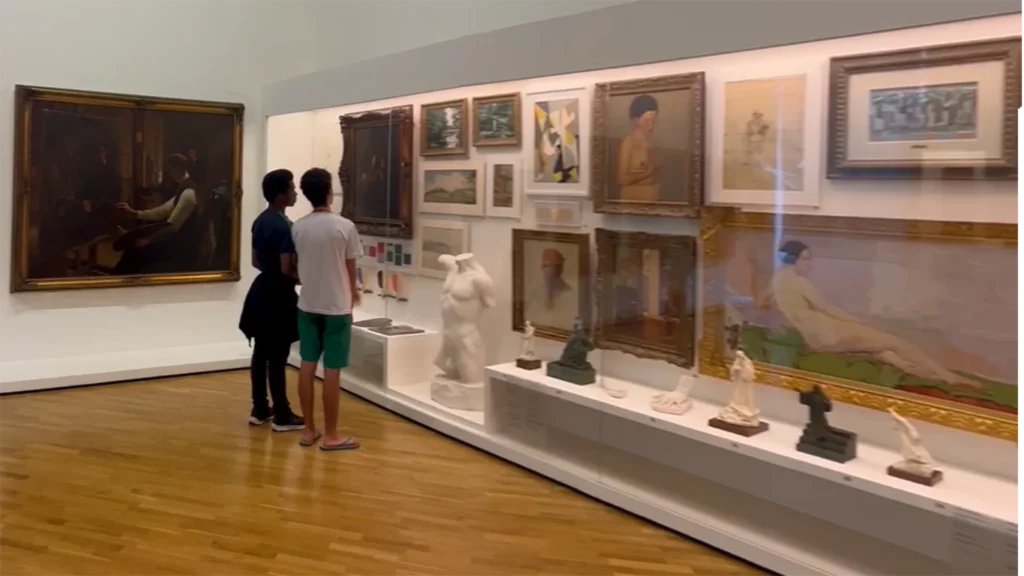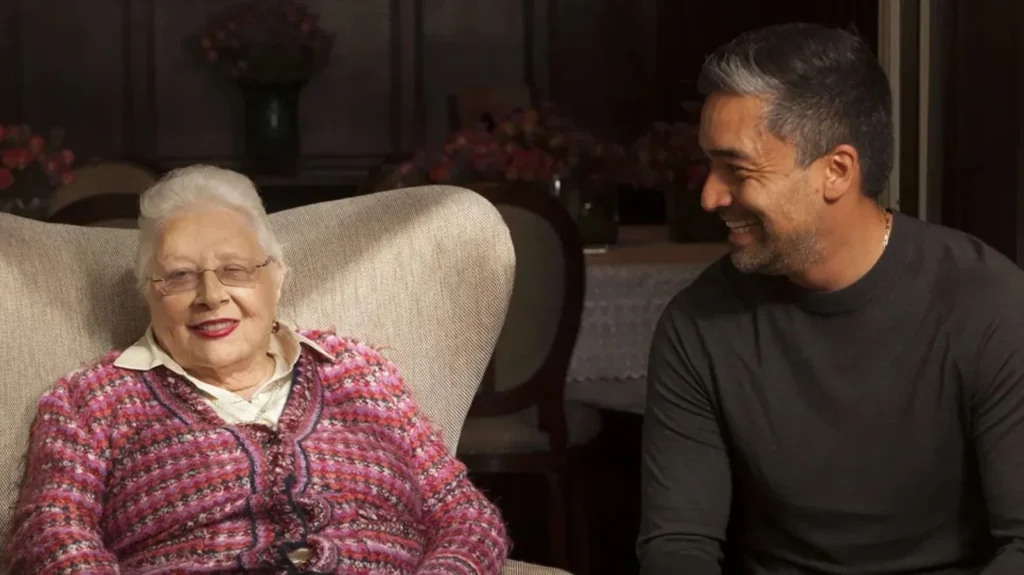The federal agency’s 30 museums have preference for cultural property sales or auctions, including the Ara├║jo art collection with Baroque relics and Brazilian jewelry. In this manner, museums could exercise their pre-emption rights, however, ultimately, it is a private foundation, not a public institution, that became the acquirer.

Polychrome wood sculpture, 100 x 70 x cm.
During the auction, Sophie Su interviewed┬ĀJustino Marinho, a well-known figure in the world of art and journalism and a friend of Emanoel Ara├║jo. Through their discussion, they shed unique insights on this historic event and on how Emanoel Ara├║jo meticulously curated his collection.┬Ā
THE CONSTRUCTION OF ARA├ÜJOŌĆÖS COLLECTION
Emanoel Ara├║joŌĆÖs initial exposure to collections was through his fatherŌĆÖs profession. Indeed, goldsmiths must possess their own collection of jewels to use as models for reproduction.
Throughout his life, he has assembled a remarkable personal collection that showcases the richness and diversity of Brazilian culture. Transcending the boundaries of art, his collection aims to question the historically dominant narratives about black identity in Brazil.

Preserving the Memory and Iconography of the Black Community
Moving to S├Żo Paulo in the 1970s, Emanoel Ara├║jo was forced to confront his own black identity when someone first said to him: ŌĆ£This is the first time IŌĆÖm welcoming a black person in my houseŌĆØ. From this moment, the idea of creating an institute to preserve the memory and iconography of the black community┬Āemerged.
To establish the institute, he bought a house next to his studio in Bixiga, S├Żo Paulo. He displayed his personal collection of objects from the 17th through the 21st centuries.
His legacy was a powerful active effort to value the Black population by showing through images that racism is primarily the result of ignorance about others.┬Ā
It was in this same spirit he established, in 2004, the┬ĀMuseu Afro Brasil, the largest museum dedicated to African and Afro-descendant culture.

Worldwide Acclaim
In 1992, he showcased his personal collection at the┬ĀMuseum B├żrengasse┬Āin Zurich. The exhibition was titled “A casa do baiano: The artist Emanoel Ara├║jo and his Afro-Brazilian collection“. It is precisely at this moment that his collection has garnered the attention of the international art world for its exceptional quality and the significance of bringing these objects together.
Emanoel Ara├║jo often mentioned that he acquired many items in the collection for a small, if not derisory, price. The sellers were frequently unaware of the value of their objects, which are now only found in museums or sold for impressive amounts.
A Multifaceted Artist, Collector and Museum Director
Throughout his career, Emanoel Ara├║jo has taken on multiple roles: besides being an artist and collector, he has assumed directorship of various institutions, authored several books, and curated exhibitions, all with the aim of promoting Afro culture and art.

From 1981 to 1983, Ara├║jo was the director of the┬ĀMuseu de Arte da Bahia.┬ĀAntonio Carlos Magalh├Żes┬Āsuccessfully requested him to relocate the museum to a bigger area. While he was in charge, the museum held important exhibitions on Afro-Brazilian culture.
Upon his return to S├Żo Paulo in 1992, Ara├║jo assumed the role of director at the┬ĀPinacoteca de S├Żo Paulo, one of the nationŌĆÖs most prominent art institutions. Prior to his arrival, the museum was practically abandoned. However, he made an extraordinary transformation by obtaining many donations of artworks and incorporating black artists to their collection.

In 2004, he established the internationally renowned┬ĀMuseu Afro Brasil┬Āand generously donated over 2.000 artworks to it over the years.
He also published several books to dedicated to Afro-descendant art:┬ĀM├Żo afro brasileira┬Ā(1988),┬ĀHerdeiros da noite┬Ā(1995),┬ĀNegro de corpo e alma┬Ā(2000),┬ĀPara nunca esquecer negras mem├│rias┬Ā(2002) and┬ĀMuseu afro Brasil o conceito em perspectiva(2006). As director of the Pinacoteca, he supported the acquisition of artwork by Afro-descendant artists featured in his publications.

┬Ā
┬Ā
┬Ā
┬Ā
Emanoel Ara├║jo,┬ĀM├Żo afro brasileira (Volume I and II), 1988/2010.
In addition, he taught graphic arts and sculpture at the City University of New York, sharing his passion and knowledge in an international environment.
As an artist, Emanoel Ara├║jo, took part in many national and international exhibitions, with around 50 solo exhibitions and over 150 group exhibitions.

at MASP in 2018.
The Social Impact of His Collection and Work
Finally, it is essential to underline the social mission of the collection and the career of Emanoel Ara├║jo. While teaching in the United States, he had the chance to discover the work undertaken by several museums. The museums’ important role in the local culture made him think about Brazil’s precariousness, not just in terms of museum presence, but also limited access to certain social classes.
Emanoel Ara├║jo had a profound social mission when he established his collection, challenging prevailing narratives about Black identity in Brazil. He once said, ŌĆ£Brazil is the country of the absurd, we are still learning to be peopleŌĆØ, underscoring the need to both conserve existing heritage and include artists and a forgotten public.
As for museums, the integration of black representation and broader accessibility are pivotal for enhancing self-esteem among people of African descent. Seeing themselves represented in these cultural institutions is an act of recognition that has long been absent. This act grants them a sense of power and legitimacy within society.

Emanoel Ara├║jo succeeded in creating a space for Black community in museums, bestowing upon them a newfound sense of power and a legitimate place within the societal landscape. The impact of his work is substantial, shaping Brazilian society and the art world.
Emanoel Ara├║joŌĆÖs commitment extended to his efforts to open a museum, which, while he preferred it to be in Bahia, faced challenges due to the underprivileged state of black people in the region. Bahia had limited resources, and political reasons favored a museum of European art. Nevertheless, Emanoel Ara├║joŌĆÖs dedication to the cause of Afro-Brazilian representation persisted, leaving an indelible mark on Brazilian society and the world of art.
FUNDA├ć├āO LIA MARIA AGUIAR
In the picturesque town of Campos do Jord├Żo, the┬ĀFunda├¦├Żo Lia Maria Aguiarstands tall as a beacon of social change and cultural preservation. Established in 2008 by the visionary entrepreneur and philanthropist┬ĀLia Maria Aguiar, this independent non-profit organization has been transforming the city’s landscape for 15 years.

Their acquisition of Emanoel Ara├║jo’s collection not only aims to keep together the pieces meticulously curated over decades by the multi-talented artist, but also marks a vital step in the foundation’s mission to nurture social, cultural, artistic, and health transformations.
Under the dynamic leadership of Director┬ĀLuiz Goshima, the foundation is embarking on an inspiring journey. They plan to create a comprehensive socio-educational park, a haven of knowledge that transcends formal education. This park will feature an environmental awareness center and interactive museums, offering immersive experiences in history, art, and culture to visitors.

Speaking about this transformative initiative, Goshima shared, ŌĆ£Our society’s roots are intertwined with our history. To foster a deep connection with our country, itŌĆÖs crucial for people to understand their origins. This newly acquired collection, a testament to Brazilian cultural brilliance, will play a pivotal role. While the meticulous cataloging and inventorying process unfolds, we are envisioning possibilities ŌĆō a museum, exhibitions, or innovative ways ŌĆō that will reinforce the social significance of this extraordinary collection.ŌĆØ
Luiz Goshima inherited from the passion for art and social issues of his father Luiz Harunari GoshimaŌĆÖs, who sadly passed away last month. It is truly a fitting tribute to carry on by adquiring Emanoel Araujo’s collection fufilling the objective to share it didactically.
Funda├¦├Żo Lia Maria Aguiar continues to uphold its commitment to building a vibrant future rooted in heritage, education, and community bonds.
Funda├¦├Żo Lia Maria Aguiar, which purchased the collection, will make it accessible to the public to preserve Ara├║joŌĆÖs legacy! Next year, another auction will be held, featuring pieces from the collection of the Museu Afro Brazil, founded by Emanoel Ara├║jo in 2004.
To delve deeper into Ara├║jo and his extraordinary collection, consult our additional article on the topic:
┬Ā
┬Ā
┬Ā
┬Ā
┬Ā
